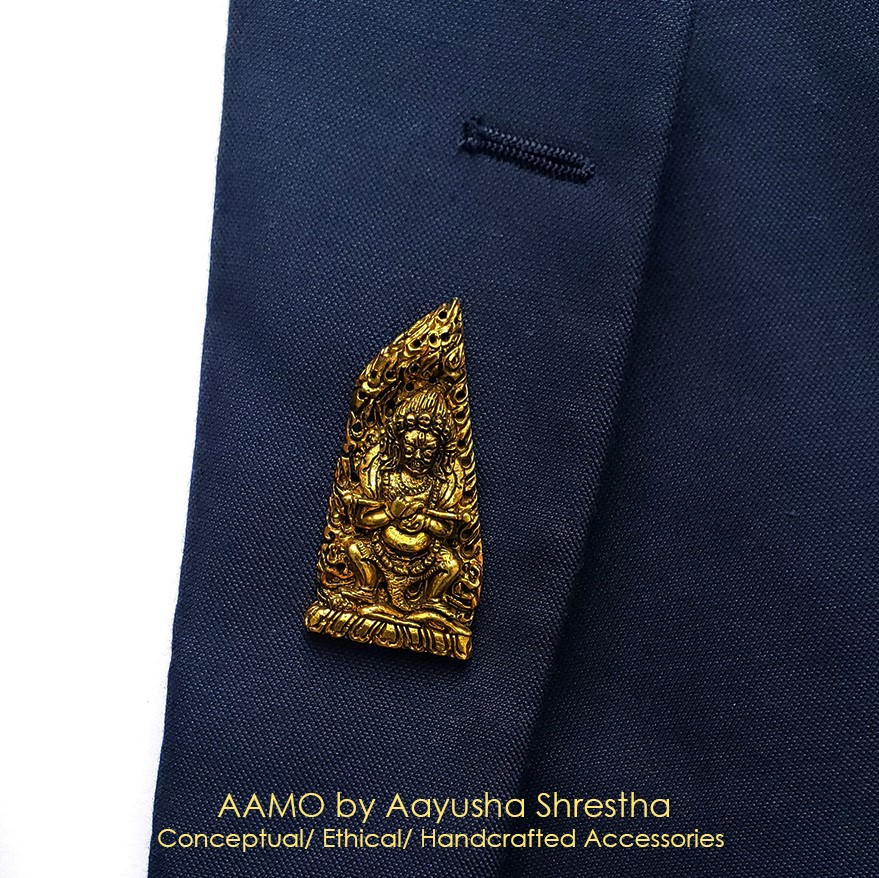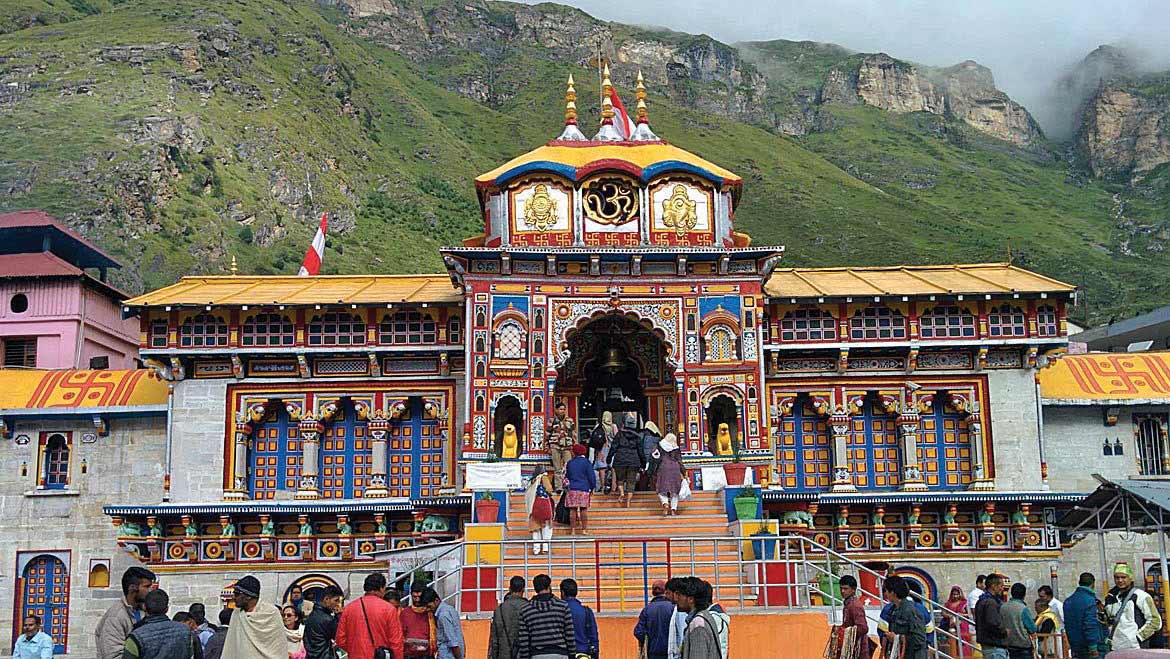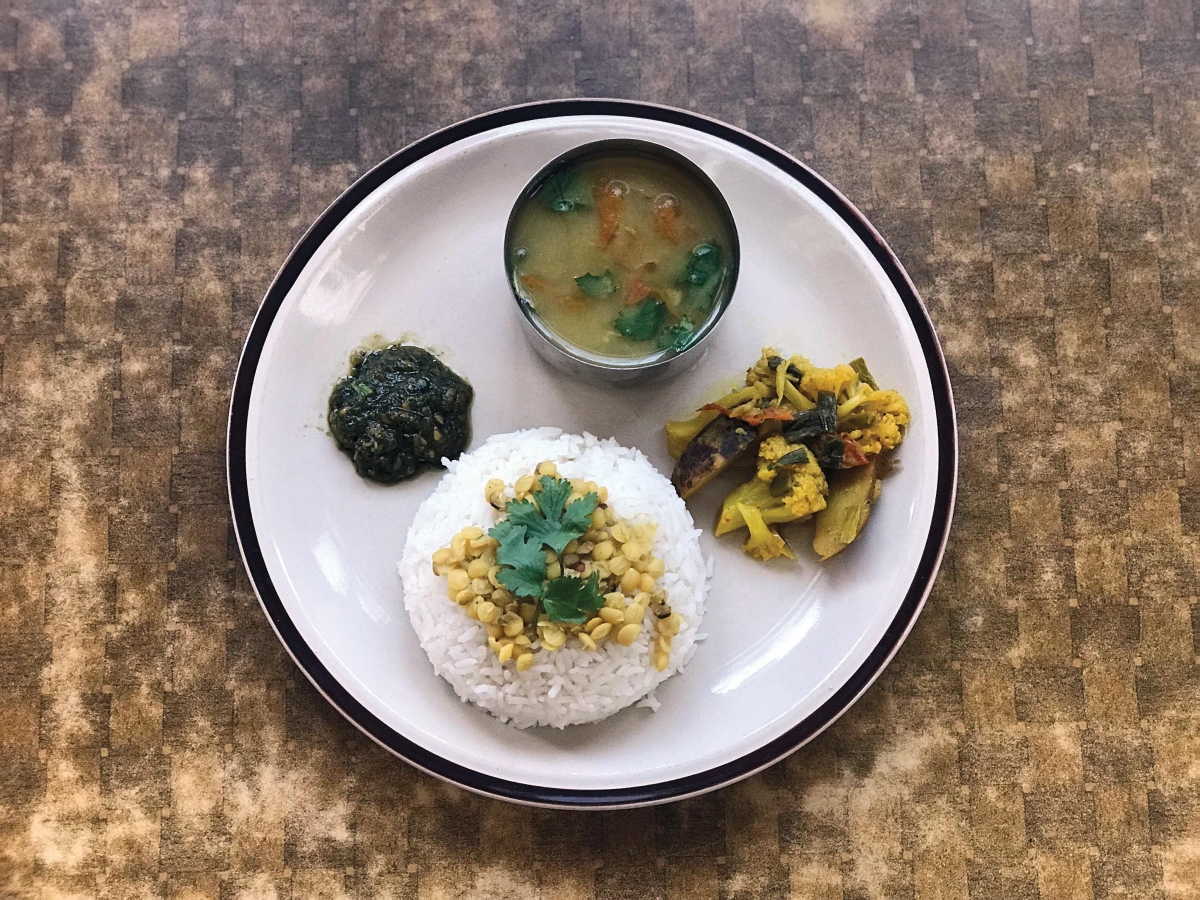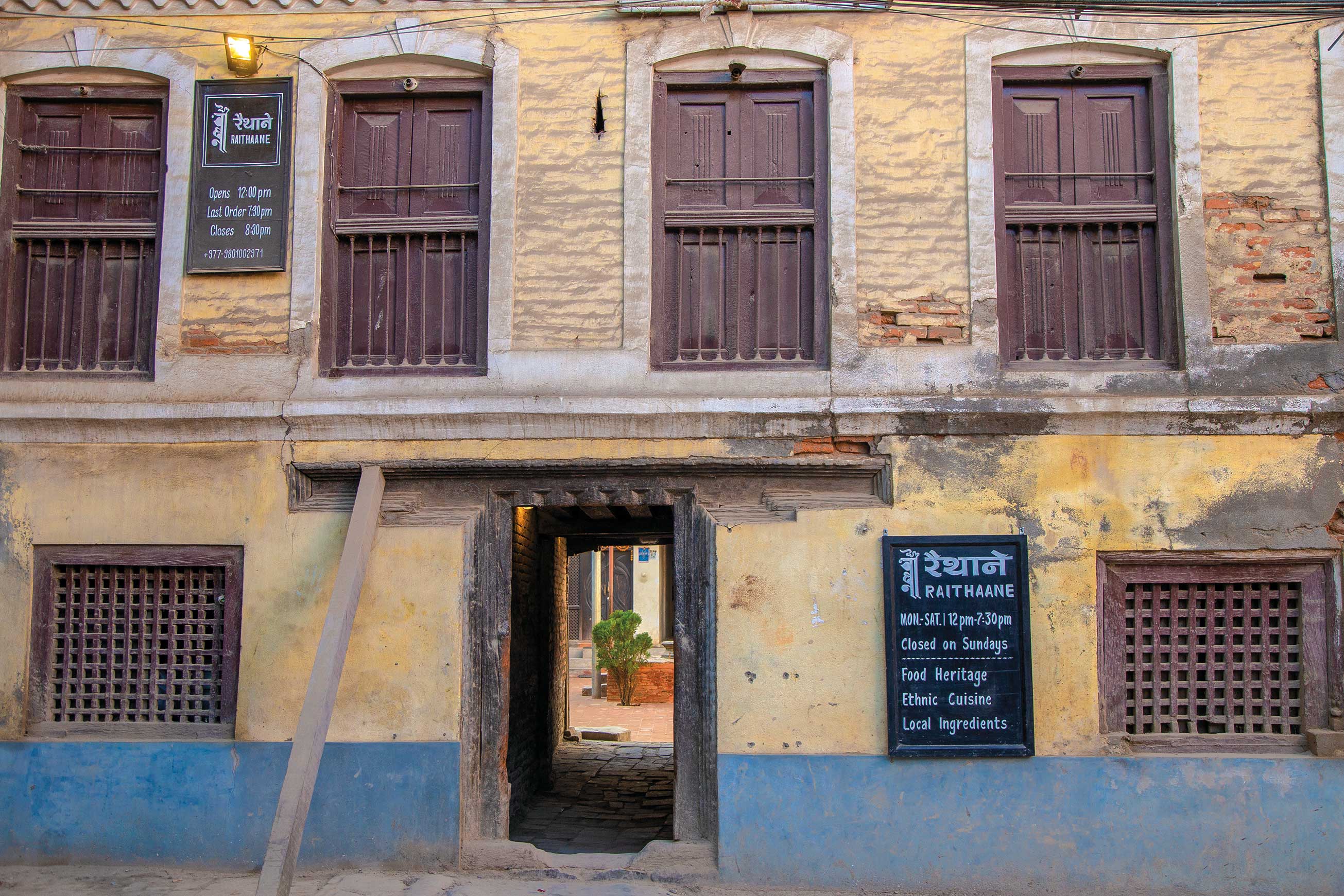In France they will say, ‘Comment ca va?’ and in most English speaking countries the common mode of greeting is, ‘How are you?’ Here in Nepal, people are more likely to greet each other by asking, ‘Bhaat khanu bhayo?’ In literal terms, this means, ‘Have you eaten rice?’ but actually it means ‘Have you had your meal?’ From this example alone, one can get a good idea of what importance the Nepalis place on food. Some have wondered whether this form of greeting could have arisen from the fact Nepal is a country where this most basic necessity of life has always been top priority. And, that is why people believe that to have a full stomach, even if for the day, is in itself something to be happy about. Whatever the case may be, now and then you might also hear the phrase, “Taanna bhat khayera sutnu ko arkai maja”. Translated, this means, ‘Sleeping on a full stomach holds its own pleasure’.
Thus, when talking about the ethnic cuisine of Nepal, it should be kept in mind that much of the different cuisines of different clans and regions of the country have been derived from the need to fill stomachs that are more often than not empty many a time rather than the practice of any special culinary skills as such. There are exceptions of course and in fact, one may be able to discern a particular clan or regions’ prosperity by the kind of dishes it calls its own. For example, one of the more prosperous ethnic groups in Nepal are the Newars of Kathmandu Valley and appropriately enough, they are famed for the variety of their cuisine. In sharp contrast, dheedo-gundruk is the most basic food of people in many remote regions in the hills and mountains of Nepal. It has not originated from great cookery skills or indeed by choice, rather its origins are based on the fact that dheedo is a great stomach filler and gundruk, the result of wise preservation of available vegetables during better times. It is another matter that nowadays, with the advent of clever marketing chaps in the cities, this most basic of cuisines is being touted as a great local delicacy. But, what is dheedo-gundruk exactly?
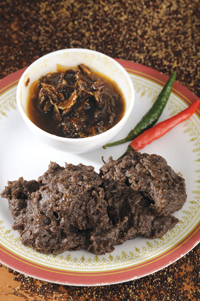
Dheedo and Gundruk ko jhol
Dheedo-Gundruk
Dheedo is a porridge-like substance made from a mixture of maize and wheat which are what are usually grown in the hilly regions where rice is a scarce and a much more expensive alternative as a staple. This is one of the ironies of this country where dal, bhat and tarkari (lentil soup, boiled rice and vegetable curry) is said to constitute the ‘national dish’, this combination being the staple meal of most Nepalis. Anyway, coming back to dheedo, it is filling and quite nutritious at the same time, even if pretty bland. To offset this blandness and make it more palatable, it is eaten along with gundruk which is fermented green leafy vegetables either pickled and spiced with various condiments or made into a soup called ‘gundruk ko jhol’. Another pickle that is commonly eaten along with dheedo is sinki which is also a fermented product, albeit of the root parts of carrots, prepared as a spicy pickle. Like gundruk, sinki can also be preserved for a long time.
The world being what it is - history repeating itself time and again, people periodically hankering for their roots, and the axiom, ‘what goes round comes around’ being proven to be often true – health pundits too are now pointing towards the many benefits of food that are natural and raw. And, what could be rawer than sun dried vegetables and raw wheat and maize flour? So, what one finds is that many tourist-targeted restaurants are certain to have dheedo with gundruk in their menus along with sinki and tama ra alu (we’ll talk about this soon).
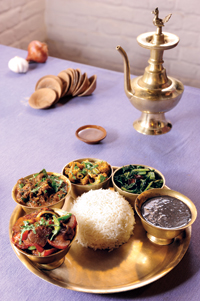
The main-course at Bhanchha Ghar
Khasi ko masu and aila
One restaurant that must be mentioned here when talking about ethnic cuisine in the capital is Bhancha Ghar in Kamaladi which has made a fortune serving dal, bhat, tarkari along with saag (spinach), tamatar ko achar (tomato pickle) and khasi ko masu (mutton curry) to hordes of eager tourists for whom a visit to this place is mandatory when in Nepal. The success of Bhancha Ghar has spawned many imitations including the opening of its own branches in various places. Most of the food they serve are good, that is for sure, and just for your information, well priced (for tourists, that is!). Not so good was the ethnic food I had once in a restaurant in Nagarkot, where the establishment had made a pitiful attempt at serving Nepali food the continental way. Imagine having to drink gundruk ko jhol as a starter! That’s just not done, my friend. And herein lies a great lesson for all those serving ethnic cuisine – it’s best served as we eat it at home and yes, it’s best eaten with the hand. Bhancha Ghar’s success can also be attributed to its serving of excellent aila (homemade fiery liquor), the downing of which makes the palate believe everything else is very tasty indeed!
Dal, bhat and tarkari is as wholesome and nourishing a combination as any meal you will find anywhere. Sag and achar provide added nutrients and taste but it is really khasi ko masu that is the clincher. Nepalis just love this tasty curry but unfortunately it has become a delicacy reserved for special occasions with the price of mutton crossing 500 rupees a kilo and putting it beyond the reach of many. However, Nepalis being very much a meat loving people, make do with the next best alternative, that is, chicken. It must be mentioned here that the Newars are particularly fond of buffalo meat (locally called buff). Its slang form is ‘thulo khasi ko masu’ which means ‘meat of the bigger goat’. This is apparently so because in days gone by it wasn’t really the done thing to go for buff meat, the implications being that you couldn’t afford to eat the more respectable goat meat!
Born Epicureans – the Newars
Nevertheless, the Newars have made buff cuisine into somewhat of an art, with every part, big and small, of the buffalo being made into a particular delicacy. Some of the most popular uses of buff meat are as fillings in mamachas (dumplings - practically the new staple food of Nepal), hakuchoila (grounded meat broiled and spiced up), kachilaa (marinated raw minced meat), takhaa (jellied buffalo meat soup), bhuttan (deep fried intestine and other stomach parts), senla mu (steamed and sautéed liver), swanpuka (lungs filled and fried), mainh (fried pieces of tongue), cho-hi (steamed blood with marrow and spices) and so on. Now, you can imagine, if the Newars can conjure up so many dishes with one raw material source alone, how diverse must be their cuisine and how innovative must be their culinary skills!
Naturally, all such heavy protein affairs need a helping hand to be easily digested, so you have the aforementioned aila (its purity of alcohol content is tested by putting a burning matchstick near to it upon which the liquor burns with a bluish flame) and thwon (homemade rice beer) to accompany meals. The Newars have equally delicious vegetarian dishes, the more popular being chatamari (rice pancake which can have different toppings), bara (lentil based fried doughnut type snack) and wo (another lentil based cake type snack). yo mari (rice-flour dough filled with brown cane sugar and sesame seeds and steamed), sel roti (a special kind of bread) and kwanti (a soup made of nine different beans) are delicacies that are prepared on certain festive occasions only. Doubtless, the Newars are connoisseurs of good food and their favorite dessert, juju dhau (special yoghurt made in Bhaktapur), aptly vindicates this fact because those who have tasted this delicious yoghurt will forever hanker for more. But now enough of Newars, Nepal as a whole has many other cultures. These can however be broadly classified as either the Terai culture or the mountain culture and the food they eat can also be so classified.
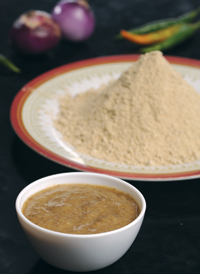
Sattu mixed with water makes for a nourishing snack
Healthful Sattoo of the Terai
The people of the Terai (lowlands) are not as innovative as the Newars in matters to do with food. As elsewhere, dal, bhat and tarkari is the preferred meal combination except that in their case, the curry and the pickles are liable to be more spicier and hotter than elsewhere. In fact, no meal is complete without a peeled onion and a couple of chili peppers on the side. Oh yes, they do love munching on red hot fiery chili peppers. They also like to eat a lot of raw onion, which from the health point of view, is a good habit since onion is said to prevent prickly heat and as is well known, the Terai has tropical climate almost all year round. One of the distinctive foods of the Terai is ‘sattoo’ which is made from maize, soybean and added gram. Obviously, it is high in protein content and can be eaten in a variety of ways. The commonest way is to mix it with water and make a thick paste which, seasoned with a little salt, makes for a tasty morsel. It can also be just eaten as it is in its dry form or it can be mixed with water, salt and a little lime juice to make a refreshing drink. The clever marketing chaps are also trying to sell sattoo (like dheedo-gundruk) in packaged form to city folks, but till now it looks like the marketing hasn’t been good enough. However, this writer can vouch for the fact that sattoo is indeed very good food, taste-wise and nutritionally. The popular drinks of the Terai are mainly mahuwa raksi, a distilled alcohol derived from the juice of a flower called Mahuwa (maduca indica), and toddy, a naturally fermented alcoholic product of sap from palm trees.
Flavor of the hills
Rice, as mentioned before, is a prized commodity in the hills and mountains, agriculture here being a tough proposition, terrain-wise and climate-wise. Many of the poorer people have to make do with dheedo and gundruk. Of course, the Tibetan influence is very strong in the mountains and so people consume a lot of noodles in the form of chowmein and thukpa and thentuk (noodle soups garnished with vegetable and meat pieces) as well as Tibetan style momos (larger dumplings than Kathmandu’s mamachas with more dough content). One dish that is very popular is T-momo, which is soft steamed dough lumps served with buff chilly (thin buff slices fried with onion and chili peppers). Because of the temperate to arctic climate, pork is much preferred over other meat because of its high fat content. In the eastern hills, a popular dish is kinema, which has a pungent smell of ammonia and is made from fermented soybean. Khatte is another dish of the hills that is popular as breakfast food. It is made from brown rice obtained from the dhiki (a manual flaking instrument). Similarly, another typical food of the hills is poko, which is the base product when making the local liquors like jandh and raksi. It is juicy and has a sweet and sour taste with slightly alcoholic and aromatic flavor. Poko is believed to promote vigor and stamina. The favorite drink of the hill and mountain folk is tongba, which is a freshly fermented barley drink served in wooden containers. One drinks through a wooden tube and keeps pouring hot water over the barley to fill up the drink from time to time. The other favored drinks are chaang (fermented product of millet or kodo in Nepali, similar to thwon) and rakshi (same as aila of the Newars). Besides these drinks, if you visit a Sherpa’s house you will more often than not be offered a thick buttery tea poured from big Chinese made flasks. This is the Tibetan style butter tea, a drink that can heat you up pretty fast.
And finally, Aalu Tama and Masyoura
Finally, there are some dishes that are as popular in the mountains as they are in the Terai. One such is alu tama. It is a curry made of potatoes and bamboo shoots. Properly cooked, the aroma can be really overpowering in the better sense of the word and the taste is like no other curry anywhere in the world. In short, it is a unique and classic Nepali curry. Similarly, another food that is unique to Nepal is masyoura which is made from black lentil and vegetable shreds that are sun dried after preparation. These are then used to make tasty curry, which again like alu tama, is a perennial Nepali favorite with a taste that lingers on - much like the various other dishes of Nepal, all delicious yet distinctive in their own way. Oh yes, Nepal might not have as famous gourmet cuisine like France or China, but it surely has an exotic variety of gastronomic fare that adds to the uniqueness that is Nepal.


